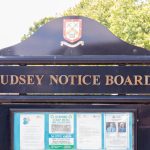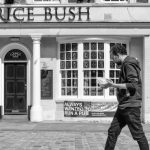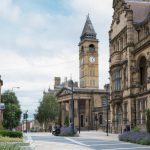Is this picturesque town in the West Ridings the ideal staycation destination?
Ilkley is one of those Yorkshire towns that has the entire spirit of the county captured within its walls. Over the many thousands of years this area has seen settlement, Ilkley has been one of the most consistently settled areas of land in West Riding. The town is considered part of the Bradford district, although it remains removed enough from the city that it keeps the country charm of West Riding. Here’s the best travel guide to Ilkley that you never knew you needed but somehow hits the spot.
What’s Ilkley Famous For?
Ilkley’s best feature lies in the moors outside of town. The interesting thing about these moors is that they include both an old quarry and early Bronze Age carvings into the rock. These carvings are consistent with the carvings scattered throughout the UK.
The mystery is that these carvings are gigantic. You can only really see the whole picture from the air. Back in the Bronze Age, people were not flying around. So were the paintings for the Gods? We think it’s dragons. It sounds like dragons. There are different burial cairns all over Yorkshire which commemorate those early people… but the history of Ilkley goes farther back than that.
Early History of Ilkley
Ilkley has a long past which reaches all the way back before recorded history. In fact, Ilkley’s history has more years in prehistory than it does in recorded history. We have reviewed plenty of places in the UK – towns, cities, settlements, villages – and this is the oldest inhabited area we have found yet; that we know about. Ilkley is ancient… so you just know that it gained a town charter at some ridiculous point like the 16th century… Let’s find out.
The carvings on Ilkley Moor date to 1800 BC, in the early days of the Bronze Age. The Rembolds Moor, the Ilkley moor, features 400+ cup and ring-decorated stones. There is a Swastika stone, remembering that the symbol was adopted by the Nazi party from earlier pagan symbology.
BEFORE 1800 BC, during the Mesolithic and Neolithic periods. This area was inhabited. Evidence of hunting, including arrowheads, has emerged throughout this area of West Riding. The area shows remnants of burial mounds and cairns from these prehistoric settlements. At some point in that early history, those humans grouped up into tribes. The local leaders were the Brigantes tribe, who were one big group of smaller tribes added together. They united under a leader named Cartimandua to defend their land. Those early people eventually submitted to the Romans, but not until after the invaders built forts to defend themselves.
The Romans erected the first circular fort here in 80 AD. They abandoned this temporarily when the Brigantes revolted. A second fort replaced the old wooden one in 161 AD. The Scots burnt this one down 30 years later. The Romans replaced it with a stone fort which lasted until they went home in the 4th century. After they went, the fort gradually wore away in the lovely English weather, but they left a wealth of artefacts and evidence behind which helped archaeologists piece together what happened during that era.
The church in Ilkley has stone carvings which date to the 8th and 9th centuries. King Edwin of Northumbria would have brought his Christians to this area then. When the Vikings attacked in 870 AD, the Archbishop of York took shelter in nearby Addingham. The West of Yorkshire received less of a Viking strikeout, although as we know some cities were pillaged. Certainly, the church thought of the Ilkley area as ‘safe’ when the Danes arrived. It was those same Danes who set up Danelaw, which governed the assignment of Yorkshire into the separate Ridings because it was too big (and full of bearded guys with swords).
Medieval Period in West Riding
After an interesting start, the area of Ilkley appeared in the Domesday Survey of 1086, which took place twenty years after William the Conqueror invaded. The Archbishop of York owned this land until the Normans arrived. Afterwards, William gifted the lands to the de Percy family, who became the most influential people in England for generations afterwards. At that time, the land consisted of 2 named owners technically, but both were William de Percy. The land included:
- 1 Priest and presumably his church, which historians think would be the All Saints Church.
- 11 villagers, 19 smallholders, and 5 free men.
- 4 acres of meadow
- Several leagues and furlongs of woodland.
- An annual value of three pounds, down from ten pounds before the war.
What’s interesting about this entry is the fact that the value of the land decreased. Of all the towns we have travelled through, we have only met two or three places which had a decreased value post-Norman arrival. Reportedly de Percy had so many other castles and land parcels that he let this one fall to waste.
Sometime around the 14th century, the Manor House at Ilkley opened for the first time. It has All Saints Church next door, which points towards the manor existing in some other form before that. The oldest part of the church date to the 1400s but that doesn’t mean there wasn’t a wooden structure before then. This particular building was built in stone in 1340. Later additions came in 1560.
As of 1314 Scots raiders would attack the North of England frequently. This was just after Bannockburn and they were creeping farther south with confidence. They were notorious for stealing cattle and plundering the Wharfdale villages. They burned homes, pillaged, and caused a nuisance of themselves to the point that the local Archbishop cursed them with a bell, book, and candle.
Ilkley, having been populated for around 2000 years by this point, finally received its market charter under Lord Percy. Down through the family a few generations, the home fell into the hands of the Middleton family. The last Middleton sold the manor to the Local council in 1893. By the time of his death in 1906, 400 years’ worth of Middletons had lived in it.
Fun Facts About Ilkley in Bradford
During every travel guide of England, we like to explore some of the fun trivia from the area. Sine Ilkley is such an ancient town; it comes with an ancient history’s worth of gossip. Don’t worry, we scoured out the best bits below:
- Ilkley truly came into its own in the Victorian period when it became a spa town.
- Charles Darwin once visited to take in the White Wells waters. He was here in 1859.
- The town’s name in early documentation was Olicana, which experts predict was the name of the Roman fort here. This possibly comes from the Old English Olifstan, meaning rough rock.
- This leads us to the fun fact that ‘flint’ in Old English is ‘flint’ as we know it today.
- What led everyone to fight over Ilkley in the first place is its unique position at a crossing in the Wharfe.
- The Roman fort is underneath the car park in the middle of town. When excavating in 1880 archaeologists found a Roman well on Brook Street, too.
- The preacher John Wesley passed through here often. He even gave several sermons around the town in the 1760s, 70s, and 80s.
- Famous guests other than Darwin include Charles Dickens, Marie Tussaud, and Lord Tennyson.
- 900 fans squeezed into the Troutbeck Hotel in Ilkley to see Jimi Hendrix perform here. The police stopped the show, inducing riots, and causing far more hazards than there might have been if they just let him play.
- The Daily Star once proved how good a source it was by reporting a local resident had taken a photograph of an alien in the moors. The story broke in 1987, but two years later the media reported it was simply a lost insurance broker who was trying to take a shortcut through the hills.
And on that delightful note, let’s return to the history. We have most of it out of the way now, but there is still that massive growth in the Victorian era to cover.
The Industrial Period
Ilkley received its first grammar school courtesy of Thomas Fairfax and Sir Mauger Vavasour. They decided a sum of £100 left by local resident George Marshall should go towards a school and master. The two room school opened in 1636 under the control of the church. This went horribly and everyone regretted it. The school was closed due to inadequate conditions in 1869. The students went to the National School in Leeds Road, instead.
By 1755 there were as many as 400 weavers between Addingham, Ilkley, and Kidwick. Textiles were a large part of the early industrial era trade. In Ilkley, the fabric was initially wool until cotton arrived, then weaving died as a trade on the whole from the 1820s onwards. The last mill closed in 1850.
During the 18th century, local legend says a shepherd’s boy had injured himself and the wound would not heal. The boy bathed his leg in the spring waters near White Wells for a few days and nights and the wound miraculously cleared. Interesting for such an incident to occur just at the same time when spring waters were a major tourist attraction… As from 1780 onwards, the town became the holy grail for those who liked to ‘take the waters’.
In 1820, Robert Collyer had a few choice words to say about the town – and none of them good. He talks about refuse, midden’s, garbage, and simple homes of a single storey. He even says that the stream ran straight down the street and he couldn’t believe it. Um. You OK buddy? We reckon it sounds like someone in Ilkley maybe hurt his wee feelings. He was the local blacksmith turned preacher, so the fanaticism kind of makes sense.
In 1840 the town was an established spa. Hamer Stansfield of Leeds returned from Czechoslovakia with an idea stolen from ‘illiterate peasant’ Vincent Priessnitz. The peasant had developed a method of healing using intensely cold water. In the true spirit of the British Museum, Hamer benefitted from the cure so much that he stole the idea and set it up in Ilkley. This attracted a whole new wave of English tourists desperate for a miracle cure. Several hotels later opened based on this practice.
The railway arrived in Ilkley in 1865, connecting the town to other areas. After this, it was a straight shot to fame. ‘Taking the waters’ was a genuine Edwardian and Victorian-era love. It was when British people started going to the seaside for their holidays for the first time. The train network connected the common family with day breaks in the sunshine and sunbathing. The discovery of the natural springs here eventually turned it into a spa town, and the rest is Victorian history.
Another church opened in the 1860s, but by the beginning of the 20th century, the hydropathy trend faltered. This led to the gradual demise in tourism which, had it continued, would likely have turned the town into a city one day.
The Modern Era
As the Hydrotherapy craze died off, Ilkley found ways to make itself a tourist attraction anyway. Efforts changed to focus on the carvings. The town gained a cinema and a pool. The residents continued to maintain that pleasant country town feeling while still living close enough to Bradford for a lengthy commute.
Modern Ilkley is a place you live to get away from it all. It is part modern, part ancient, and it has a 100% chance of capturing hearts and minds. Visit it, explore it, enjoy it, and make those crucial family memories while you are there. Heaven knows that British towns need all the tourism they can get.
Famous People from Ilkley in West Riding
There are famous people gracing the north from Wallsend to Newcastle. Yorkshire has a reputation for excellent tea and comedians. Let’s see how many of these famous people came from Ilkley:
- Probably the most famous Ilkley resident is Allan Titchmarsh.
- Actor Max Brown is an Ilkley resident.
- Pro golfer Mark James grew up here.
- Royal Ballet award-winning ballet star David Gayle MBE is from Ilkley.
- Playwright Willis Hall was an Ilkley resident.
- And Kim Joy, the famous baker and recipe book writer, is from Ilkely.
The Best Attractions in Ilkley
Whether you are passing through and staying just a single night, or whether you are here for a full month of fun, try to see these best bits of Ilkley while you are in town.
Historic Sites
The biggest historic ‘asset’ the town has is Ilkley Manor House. This Grade 1 listed building dates all the way back to 1340. You can find it right next to the equally historic church. If you are interested in history in Ilkley these are the main two indoor attractions you should see. Top it off with the epic and vast Bronze Age carvings up on the moors.
Landmarks
The Bronze Age carvings on the moor above town is part landmark, part treasure hunt. Take the kids along and let them try to find as many of the 400 known rock carvings that they can. The most famous is the Swastika Stone which is on a flat slab inside Woodhouse Crag. There are also larger circles which you see best from above. The rock is gritstone and some parts are boggy. Wear your good hiking boots for this attraction in Ilkley.
Both historic and landmark, the White Wells have been famous since 1703, when they first started welcoming guests. Locals built several Victorian era hydros all over town. One of these was White Wells. Scientists have since found that the water here stimulates the sense due to the coldness, not due to any specific minerals. Nevertheless, the Victorians flocked here in their masses to bathe.
Cultural Attractions
If you were to visit All Saints Church, you would find several Saxon crosses which previously stood in the churchyard. These crosses moved inside for preservation. Although the church has stone carvings dated to the 8th or 9th century, the Saxon crosses help determine that this has been a place of worship perhaps even longer than that. Some sources put the church as first built in the 7th century. The Romans had a history of building temples on existing religious sites when they invaded. That way, they could merge their Roman beliefs with these new Gods, slowly overtaking the natives belief systems. We, in turn, adapted those temples into churches when Christianity arrived. Since then, everyone has mostly been winging it.
While you are in town, try to catch a play at the King’s Hall and Winter Garden. This is also an event and wedding venue.
Let’s not forget that the town has its very own Toy Museum, either. This museum has exhibits on toys through the ages. They have a large collection of toys from throughout the ages and from all over England. The museum is in the town centre and you can find out more on the website. Old toys aren’t creepy. Not at all. Not one bit.
Recreation
There are two community centres in the area. The Clarke Foley Community Centre and the Ilkley Youth Community Centre. The town also has a large library where you can learn about any subject you like. Ilkley Cinema is another local’s favourite.
Outdoor Attractions
If you love the outdoors life and you already saw the stone carvings on Ilkley Moor, head to the Ben Rhydding Nature Reserve, instead. These former gravel pits are home to birds, plants, butterflies, and more. Go in the second week of June to see their famous orchids.
Sports and Teams
The town’s local cricket club dates as far back as 1850. The players first started on the ground behind the New Inn, which is where Lister’s Arms are now. They played on the old Crescent Grounds and moved to their own grounds afterwards.
The Rugby Club in Ilkley began in the 1870s although the club didn’t name themselves officially until 1879. They have played on their current grounds since 1920.
There was a tennis club in 1880 which became one of the top competitions to enter in the 19th century.
If golf is your game, head to the Ilkley Golf Club. First built in 1890, the golf club has since expanded from 9 holes to 18. It is the third oldest golf club in Yorkshire.
Shopping and Eating/Drinking in Ilkley
The main shops are in the town centre. You have the usual suspects, including TOFS, a Mountain Warehouse for the explorers, and even a bookshop. Try the Olive Branch or the Create Café for a light bite. You can find Steaks at the Ilkley Cow and Italian food in Piccolino.
Other Notable Attractions
We know of several nearby towns and cities that you can pop into while you are in Ilkley. These nearby tourist spots are right on your doorstep:
- Head to the River Calder and see Dewsbury.
- Tour the ancient cathedral at Ripon.
- Explore Halifax and the Calder Valley.
- Visit the coast by seeing Morecambe.
How to get to Ilkley?
We would be shoddy guides if we didn’t tell you how to get there. However, we give equally shoddy directions. The choice is yours but we would definitely take a map.
By Road
If you take the A65 north out of Bradford, you will surely see a sign for Ilkley.
By Rail
Look for Ilkley Station, best accessed from Bradford.
By Air
The nearest airport is Leeds Bradford.
By Sea
Unfortunately, you are landlocked, but it did mean the Vikings didn’t getcha.
Got Five Minutes?
If you can spare another five minutes, there are some interesting ways you could spend that time. Read more of our travel blogs on the Five Minutes Spare website, see our hobbies, or follow us on Facebook for sporting updates. Learn a new skill, escape out of a window, or jump off a mountain in a wing suit. Everything is possible when you have Five Minutes Spare.




